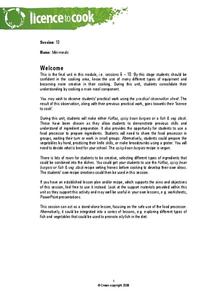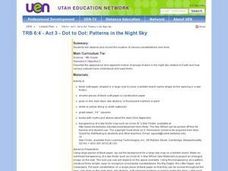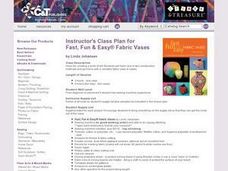Curated OER
Paper Bag Butterfly Puppets
Whether you're using it to tell stories, explore the letter b, or during a life science lesson, these butterfly puppets will be a hit. Youngsters use crayons, tissue paper, and paper bags to create butterfly puppets.
Curated OER
Watercolor Rainbow Fish
Students experience an art project as a follow up to reading The Rainbow Fish.
Curated OER
Mini Meals
Learners discuss what makes a healthy and balanced meal, and then they make them out of clay. They use hand building techniques, radial design, and their knowledge of healthy foods to create unique mini-sized meals for a wall display.
Core Knowledge Foundation
A Time for All Seasons - Spring
Celebrate the arrival of spring with this fun primary grade science unit. Engaging young scientists with a variety of hands-on activities and inquiry-based investigations, these lessons are a great way to teach children about...
Berkshire Museum
Camouflage!: Collecting Data and Concealing Color
Help young scholars see the important role camouflage plays in the survival of animals with a fun science lesson. Starting with an outdoor activity, children take on the role of hungry birds as they search for worms represented by...
Curated OER
A Waste Not Picture Frame
Students reuse old puzzles with missing pieces by painting the remaining pieces and using them to make a picture frame. They embellish the frame with other recycled items.
Curated OER
Kente Straw Weavings
Fourth graders explore world culture by creating an arts and crafts project in class. In this weaving instructional activity, 4th graders identify the Kente culture and their uses for straw and other natural elements in their...
Curated OER
Imagination Travel
Students watch video segments on shapes and patterns. They create their own pattern within shapes.
Curated OER
The Final Word
Although this instructional activity is based on “Final Word,” Craig Wilson’s USA Today column, the strategies could be adapted to any local columnist. After reading three articles independently, groups share observations about content...
Curated OER
Batlik- Art of Japan
Eighth graders will examine the use of Japanese ar tforms. The paper lantern is the example drawn from for learners to connect with the culture. The end result is a creative project that should reflect the culture of Japan.
Curated OER
Dot to Dot: Patterns in the Night Sky
Sixth graders are introduced to several major constellations and locate them in the night sky. They graph the constellations on grid paper and work in groups to research common myths and stories associated with specific constellations.
Curated OER
Shoe Box Archaeology
Learners assemble a shoe box following a layered pattern alternating between soil and artifacts. The layers of artifacts begin with the grandparents and end with the student's own personal possessions.
Curated OER
Paper Clay Fish Sculpture
Why not get creative and use paper clay to create colorful fish sculptures? All the steps needed to complete this activity are included. Your class will sculpt beautiful fish while exploring color, shape, and creative thinking. Use these...
Curated OER
Cooler In The Shadows
Students investigate the concepts of shadows and how they are projected with objects different positions in relation to the sun. They conduct an experiment by observing objects in different positions. Then students record the observations.
Curated OER
Two Sides, Same Coin: How Political Beliefs Influence Language Use
Learners read several magazine articles on the same topic written from different political perspectives, paying particular attention to the diction, syntax, and arguments presented in support the point of view expressed. They then select...
Curated OER
Fast, Fun & Easy Fabric Vases
Young scholars construct a fabric vase as shown in the book, "Fast, Fun & Easy Fabric Vases" by Linda Johansen. They cut fabric and appliques using plastic templates then iron on fusible interface. Pieces of the vase are then sewn...
Curated OER
The Water Cycle: A Repeating Pattern in Nature
Students are introduced to the terms related to the water cycle in their native language. In groups, they describe the steps of the cycle using different materials found in their art classroom. They describe how energy helps water...
Exploratorium
Disappearing Act
Crafty critters are camouflaged to escape predators, and crafty science pupils can construct a camouflage demonstration. They work with a partner to show that as a camouflaged animal moves, it becomes more visible.
Dick Blick Art Materials
Painted Story Quilt
Creating story quilts is a great way to combine art, social studies and literature. Kids select a story, a published one or one of their own, to illustrate, paint on a canvas square, embellish, and mount on a felt backing.
Curated OER
Colored Sand Creation
Students utilize beach materials to create an art project. In this arts and crafts lesson, students utilize chalk, glue, sand and markers to create a beach style design. Students utilize different colored sands to create...
Curated OER
Aztec Sun God Sculpture
Students create their own Sun God Sculptures. In this Aztec art lesson, students create their own Sun God Sculpture. After finishing the project sudents compare and contrast their sculpture to the pictures of the Aztec's sculpture.
Curated OER
Miriam Schapiro Action Figures Collage
Young scholars create a background with a marbling technique. They plan and create a figure from assorted papers, mixing solids and patterns. Students glue the figure to the background, and embellish negative space with glitter.
Curated OER
Explore: 2nd Grade Camouflage
Second graders discuss camouflaging in animals. They create camouflaged animal artwork out of various craft and art supplies and then see how well the creation blends into an outdoor area.
Curated OER
Cut-Glass Mosaic Garden Stepping Stones
Students design and create a mosaic glass collage. In this mosaic art activity, students complete lessons to learn about mosaic art and design. Students watch their teacher demonstrate the project and then create their own mosaic glass art.























